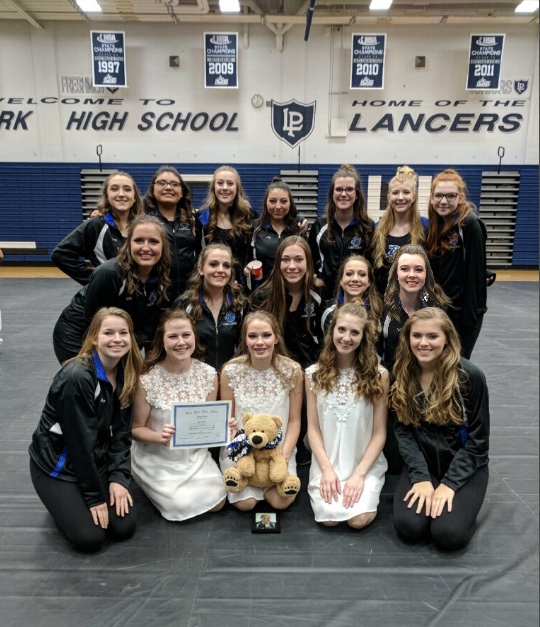Starting the seasons of twirling: Fall Guard tryouts begin
Photo by Megan Monoson
This past April, Winter Guard placed second at the Midwest Color Guard Circuit Championships (MWCGC) in LaPorte, Indiana after competing in the circuit’s largest division. With Fall Guard tryouts approaching, the team is looking for anyone interested to attend this Thursday’s clinic and tryout for the team next Wednesday, May 16.
What is guard?
Although members say many people do not know the true intensity of guard until they have tried it, members also encourage anyone interested in guard to come try it out.
Those who plan to tryout should attend their yearly clinic, according to Karenna Savage, junior Fall and Winter Guard captain, to be more so prepared for tryouts the following week.
“We make videos with all of the moves after each clinic, but it’s really hard to pick it up without being there in person,” Savage said.
Clinic participants should wear leggings and a t-shirt. Flags and everything else required will be provided.
Misconceptions about guard
While many do not realize that guard has two seasons at the high school, there are also many more misconceptions about the activity, according to Savage and Megan Kaminski, senior Fall and Winter Guard captain.
“I feel like people just don’t really know what it is, and you kind of have to explain what it is,” Kaminski said. “I feel like a lot of people don’t know about it or they don’t really know how much you have to put into it. For Fall Guard, it’s easier, but for Winter Guard, there’s a lot more that goes into it. Everyone is always like ‘it must be so easy’ […], but, actually, it’s not.”
With people’s lack of knowledge about guard, Kaminski and Savage also say another misconception is that people believe that it is an activity they can just “pick up” whenever they want to.
“I think that, usually, when people think of color guard, they think ‘Oh. Those are the flag girls.’ It is harder than it looks, honestly. It takes some coordination to learn how to do it all,” Savage said. “It’s funny watching people pick it up for the first time.”
Twirling flags may seem like an easy task to those watching, but Savage says it is tough because, when initially learning, it takes perseverance to master the skills.
“I definitely think that perseverance is really hard in guard because it does take a lot of work to get some of these bigger skills, so a lot of people tend to get kind of defeated if they can’t get it on the first try,” Savage said. “It really does take a lot of work to perfect something.”
Although the activity takes a lot of practice to become good at, according to Savage, beginners are told to try their best and try new skills without fear. Sometimes, however, guard members do get injured from learning new skills or dropping their flag or weapons.
“You’re encouraged to try things, even if you probably won’t get it the first try. We bring a helmet to practice,” Savage said. “It’s funny, but yeah we have definitely have gotten concussions and broken toes from dropping things.”
When initially hearing that you toss weapons into the air, many people become concerned with the safety of the activity, however, Savage says the flags and weapons they throw only weigh about two pounds and are not dangerous by themselves.
“They’re not actual sabers or rifles. The rifles are wooden, so, I mean they are still relatively heavy and it does hurt if you drop it, but it’s not going to fire or anything. They’re made of wood, and then the sabers are made of metal. The [sabers] are, I guess, technically actual sabers, but they’re covered in padding and not sharp at all,” Savage said. “They’re not very heavy, but it’s definitely harder to pick up the skills for rifle and saber just because they’re so much smaller than a flag so it takes a lot more precision to learn the moves.”
Once the precision is mastered, according to Kaminski, guard becomes less dangerous because you learn how to prevent injuries.
“It’s kind of just because there are a lot of injuries that can happen because of them, whether its dropping it on your foot or, a lot of the times, if you catch it wrong, you can jam your fingers,” Kaminski said. “Once you kind of have been doing it for a while, you get used to not just hurting yourself, but also how to prevent yourself from hurting yourself. The longer you’ve been doing it, I guess, the less dangerous it is, but, at first, it can be kind of dangerous.”
Fall Guard
The first season of guard is called Fall Guard and goes from May to the end of football season. This season is where members learn new skills and improve their old ones in preparation for their performances at football games.
“Fall Guard is basically during the summer and the beginning of the school year. We’re basically with the band the whole entire time. We go to Band Camp with the band. It’s so much fun, and then we also do our own camp over the summer at Carthage,” Megan Kaminski, senior fall and winter guard captain, said. “[We] basically just build up our skills on flag and with performing so then, when we go to football games, we’re better at doing both of those things.”
Practicing twice a week, according to Kaminski who has experienced both seasons of guard, makes Fall Guard less stressful and more for practice. Junior fall and winter guard captain Karenna Savage agrees.
“Fall Guard is really fun because it’s way more laid back,” Savage said. “We just get to know the team, get to know all of the girls, and get to play fun team-bonding games in a way more relaxed environment.”
Without competitions during Fall Guard’s season, returners try to make the atmosphere more about learning and fun instead of perfection, according to Savage.
“Our goal in Winter Guard is definitely to be perfect and really precise with everything because we are being judged, but in Fall Guard, since it’s [performing] football games and it’s not really a competitive environment, we like to make it more about team bonding and getting to know each other rather than making everything super perfect,” Savage said. “It is really hard and it takes a lot of work to get everything to look in sync, so we’re not super strict about Fall Guard. We want it to be more of a fun environment than be really harsh about it.”
Winter Guard
Following Fall Guard is the second season of guard known as Winter Guard, and, according to Savage, this season is more intense.
“Winter Guard is a competitive season, so we choreograph one routine with a choreographer, and then compete from January to April,” Savage said. “Winter Guard is really fun to actually put in a lot of work into something and make one routine that is really good. You get really close to all the girls because you spend so much time with them. It’s crazy, so just being together for Winter Guard is kind of when we form a family.”
Unlike Fall Guard, Winter Guard practices three times a week and even comes in on some weekends for eight hour-long practices, but Kaminski says it’s these long practices that bring the team together.
“I think, just [with] the really long practices we have on weekends, being there together for that amount of time, and working through all of the challenges that we discovered along the way [..] brought us closer together,” Kaminski said. “Also, at our first competition, we got second place, and then the second competition is when we got first place, so I feel like working from the point where we first competed to the second competition and going from second to first both also brought us closer and helped us bond more.”
During these long practices are when the team receives their choreography that they compete about five times before attending their largest competition known as the Midwest Color Guard Circuit Championships (MWCGC) held every April in LaPorte, Indiana.
“We have a choreographer who we pay to come in for Winter Guard. For Fall Guard, the captains choreograph our own routines,” Savage said. “Also, we have various dance specialists that come in throughout the [Winter] season too, and they’re super intense about the level to which we perform.”
This intenseness of Winter Guard and other winter sports and activity conflicts also break the team in half from Fall Guard to Winter Guard, according to Kaminski, because normally only half of the team that does Fall Guard also does Winter Guard. With only half the people continuing into the competitive season, the team still manages to compete “in the biggest division in all of the circuit” at MWCGC, according to Savage.
“Winter Guard routines have basically three main elements: dance, flag, and then weapon. We also twirl rifles and sabers in the winter season. We kind of incorporate all of those together, and it’s a lot more dance-oriented than the Fall Guard season just because we get points for movement,” Savage said. “Usually, it’s a three minute routine consisting of different parts with flags, rifles, sabers, and dance. Not everyone has to twirl everything. Typically, what we do, is we have a flag feature where everyone is on flag and also a rifle feature where everyone is on rifle.”
This year, the team competed a lyrical routine and received second in SRA Class 2 last month, and wants new members to join them for this year’s Fall and Winter Guard teams. For more information, email coach Reimann at [email protected].

As a senior in her third year on staff, Megan (spelled the right way) will be taking on the role as Magazine Editor-in-Chief of Bear Facts Student Media....

